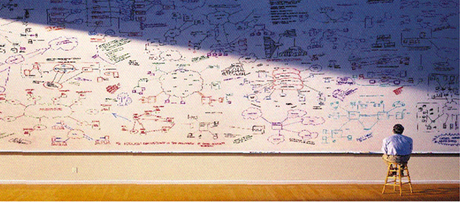Normally we are asked to help people or teams to get ideas. Because they are stuck, running around in circles, blocked, don't have inspiration or are just not creative "by nature". However, in most of the cases they lack creative thinking tools by wich they can create deliberately alternative approaches or construct systematically breakthrough ideas.
But sometimes we are asked to help by people who do have abundant ideas when asked for. Attentive listening to these people is very tiresome. A barrage of ideas that fan out to a wide range of directions and detail. Associations tumbling over each other and sometimes it seems that the flow of thought got out of control.
This is an amazing contradiction: not getting ideas by having too much ideas.
Once we coached someone who wanted to set up a netwerk event to bring into contact investors with promising start-ups. An oppportunity took place in the form of a nearby luxery trade fair targeting wealthy people. The fair would be held in and around a port for yachts. How could he benefit from this event?
We need a desk that connects startups with investors. Short pitches. Ludic name cards. A network game. Maybe we can stream the event and do it parallel in London. Oh yes, special catering. We need tents at the trade fair venue. Some presentations about the future. A store with succes stories about start-ups. We have to ask permission or hire an area for the event. Good coffee. Reverse pitches: not the start-ups will present there ideas, but investers will pitch the kind of ideas or projects they had like to support. Perhaps we could have some robots that serve snacks . . .How to intervene as an idea facilitator? Obviously, there is no need for applying a creative technique; it could even disturb the flow of ideas. Nor would it useful to structure all the ideas or, worse, to redirect the thinking to seizing the opportunity: wealthy people who are already there (and might be interested in investing).
We listened carefully, jotting down keywords in the brainstorming mode of a mindmapping software program. After the session we grouped all ideas in categories, so we got some broad directions. Actually, we looked for underlying idea areas, for example: In What Ways Might We bring investors in contact with starters. IWWMW provide catering for a spoiled audience? IWWMW provide for a follow-up once a contact is esthablished? IWWMW interest investors? We would send him the mindmap in the evening to reflect on it, add ideas and ask for "forgotten areas"; areas where there is a need for ideas but not yet been covered.
Now we had uncluttered all idea noise in client's mind, we could proceed exploring areas that were more important than others, leaving other areas of minor importance for later.
We explored a neglected area: IWWMW get permission to set up a tent in the area, without paying (too much) for it. In hindsight, the most essential for the whole event. After generating some obvious ideas (bribe the organisator of the luxery trade fair, give them free tickets, make a deal that visitors could also participate in the network event). client applied a well-known TRIZ technique: Use Resources: make a list of actors and factors that surrounds your problem. Imagine how those actors and factors could help to solve the problem.
What is there in and around the port that could help to get permission to set up a tent in the area, without paying (too much) for it?

In a split of a second: organize the network event on a yacht in the harbour.
In that way you don't have to hire a venue, or to get the permission to set up a tent somewhere. This solution is even more attractive: Get On Board of the Future.
To get some more or even too many ideas for curing a Too Many Ideas Syndrom (TMIS):
In our next post: Too many ideas and no money- fundraising your ideas.

